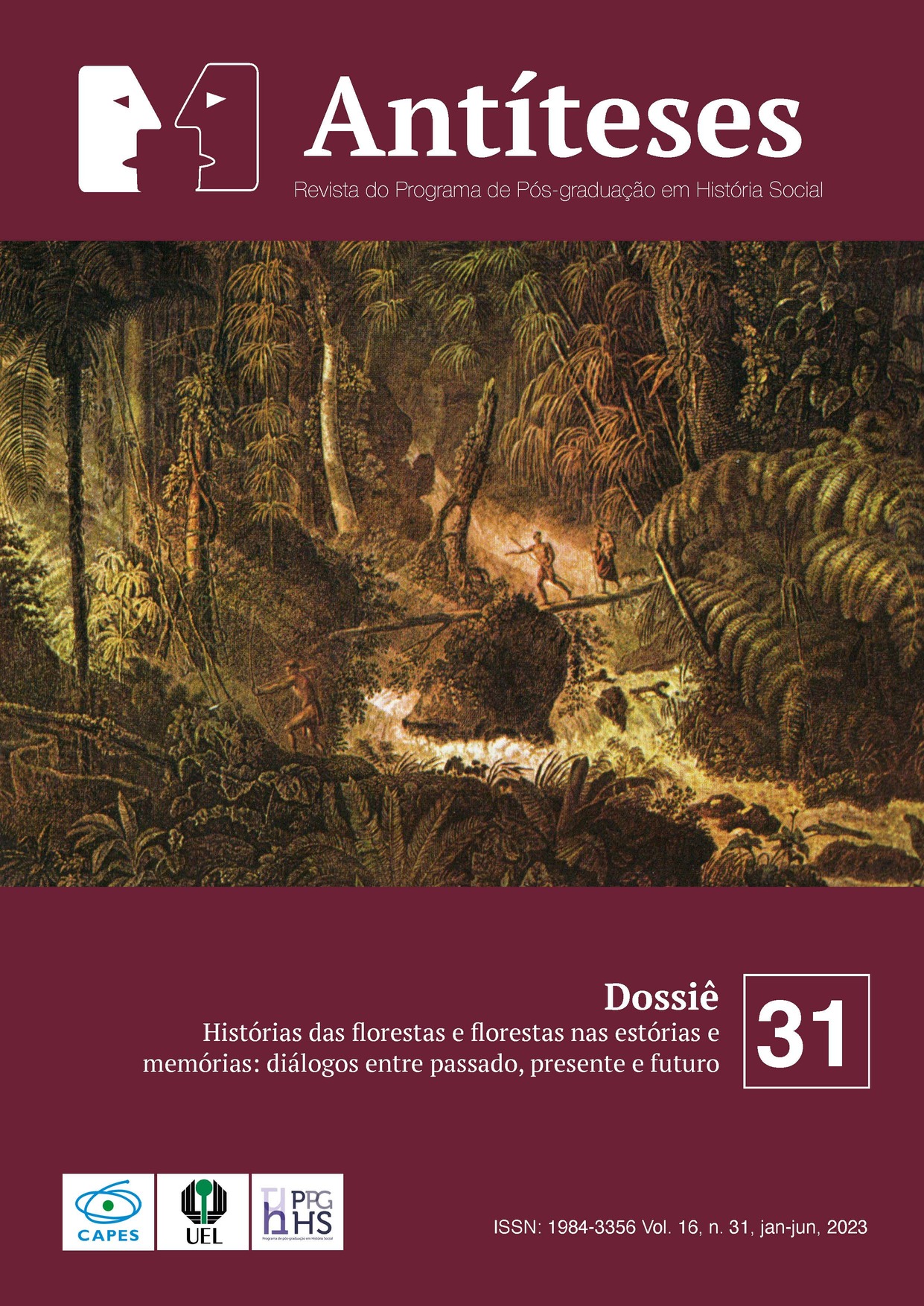"No tree in God's garden was as beautiful as him"
Religious tourism and extinction of the Lebanon's cedar forest in accounts by Protestant missionaries in the Middle East
DOI:
https://doi.org/10.5433/1984-3356.2023v16n31p114-142Keywords:
Lebanon Cedar, Environmental history, Protestant Missionaries, PilgrimsAbstract
This article, from the perspective of environmental history, seeks to demonstrate how religious tourism, in the nineteenth century, became one of the factors that contributed to the devastation of the cedars of Mount Lebanon and to establish the connection between biblical literalism and the defense of the preservation of the forest of native cedars threatened with extinction, according to reports of naturalist travelers of that time. Finally, it is intended to answer the following question: why some biblical passages about the nature of the cedar forest on Mount Lebanon, a sacred place of pilgrimage for Christians, were put in check by science? To clarify this investigation, diaries of naturalist travelers, reports of Protestant missionaries in Syria and the press were consulted.
Downloads
References
AIELLO, Anthony S.; DOSMANN, Michael S. The quest for the Hardy Cedar-oflebanon. Arnoldia: The Magazine of the Arnold Arboretum, [s. l.], v. 65, n. 1, p. 26-35, 2007. Disponível em: https://arboretum.harvard.edu/stories/the-quest-forthe-hardy-cedar-of-lebanon/. Acesso em: 5 fev. 2023.
ALLON, Henry. Recent travels and explorations in Syria. The British Quarterly Review, New York, v. 57, p. 75-97, July 1873.
ANDRESON, Mary Perle Anderson. The cedars of Lebanon. Torreya, New York, v. 8, n. 12, p. 287-292, Dec. 1908.
AZAIS, Pierre; DOMERGUE, Charles. Journal d'un Voyage en Orient. Avignion: Seguin Ainé, 1858.
BÍBLIA interlinear. Disponível em: https://www.nepe.wab.com.br/interlinear/?livro=13&chapter=14&verse=1. Acesso em: 14 jan. 2023.
BURTON, Richard Francis; DRAKE, Charles F. T. Unexplored Syria. London: Tinsley Brothers, 1872.
BURTAN, Isabel. The inner life of Syria, Palestine, and the Holy Land. London: Kegan Paul, Trench, 1884.
BUSH, George. Illustrations of the Holy Scriptures. Philadelphia: Lippincott, 1856.
CONRADIE, Ernst M. Towards an ecological biblical hermeneutics: a review essay on the Earth Bible project. Scriptura: Journal for Contextual Hermeneutics in Southern Africa, [s. l.], v. 85, n. 1, p. 123-135, 2004.
CARNE, John. Syria, the Holy Land, Asia minor illustrated. London: Fisher, 1836.
CHRIST, Konrad Hermann Heinrich. The cedar of Mount Atlas. Garden and Forest, New York, p. 246-248, May 1890.
CUINET, Vital. Syrie, Liban et Palestine, géographie administrative, statistique, descriptive et raisonnée. Paris: Leroux, 1896.
DALTON, Anne Marie. Ecotheology. In: CASTREE, Noel; HULME, Mike; PROCTOR, James D. Companion to environmental studies. London: Routledge, 2018. p. 271-274.
DORON, Bar; KOBI, Cohen-Hattab. A new kind of pilgrimage: the modern tourist pilgrim of Nineteenth Century and Early Twentieth-Century Palestine. Middle Eastern Studies, [s. l.], v. 39, n. 2, p. 131-48, 2002.
FROLLO, Jean. Le Cèdres du Liban. Le Petit Parisien, Paris, p. 1, 6 janv. 1914.
HARRIS, Thaddeus Mason. The natural History of the Bible. Boston: Wells & Lilly, 1820.
HOOKER, Joseph Dalton. On the Cedars of Lebanon, Taurus, Algeria, and India. The Natural History Review, London, v. 2, n. 5, p. 11-18, Jan. 1862.
HORRELL, David G.; HUNT, Cherryl; SOUTHGATE, Christopher. Appeals to the Bible in ecotheology and environmental ethics: a typology of hermeneutical stances. Studies in Christian Ethics, [s. l.], v. 21, n. 2, p. 219-238, 2008.
JAENNEL. Du déboisement considéré comme cause de dépopulation et des moyens d'y remédier: Association Francaise pour l'avancement des Sciences Fusionnée avec L'association Scientifique de France. Paris: Au Secrétariat de l'Association, 1891.
JESSUP, Harry H. Fifty-Three Years in Syria. New York: Fleming H. Revell Cia, 1910. v. 1.
JESSUP, Harry H. The natur at the Cedars of Lebanon. El Arz, Beirut, v.1, n. 10, p. 78-79, 1889.
JOURNAL DES DÉBATS, Paris, p. 3, 17 set. 1881,
L'INTRASIGEANT, Paris, p. 2, 4 ago. 1880.
LIPHSHITZ, N., BIGER, G. Cedar of Lebanon ("Cedrus libani") in Israel during Antiquity. Israel Exploration Journal, Jerusalém, v. 41, n. 1/3, p. 167-175, 1991.
MURRE-VAN DEN BERG, H. William McClure Thomson's the land and the book (1859): pilgrimage and mission in Palestine. MURRE-VAN DEN BERG (ed.), H.L., New Faith in Ancient Lands. Western Missions in the Middle East in the Nineteenth and Early Twentieth Centuries, Studies in Christian Missions 32, Leiden: Brill, 2006, 43- 63.
PÁDUA, José Augusto. As bases teóricas da história ambiental. Estudos avançados, São Paulo, v. 24, n. 68, p. 81-101, 2010.
PÁDUA, José Augusto. Localizando a História do Antropoceno: o caso do Brasil. In: DANOWSKI, Déborah; VIVEIROS DE CASTRO, Eduardo; SALDANHA, Rafael. (org.). Os mil nomes de Gaia: do Antropoceno à Idade da Terra. Rio de Janeiro: Ed. Machado, 2022a. v. 1, p. 187-217.
PÁDUA, José Augusto. Vivendo no antropoceno: incertezas, riscos e oportunidades. Antropoceno hoje: onde estamos? Rio de Janeiro: Museu do Amanhã, 2022b. Disponível: https://museudoamanha.org.br/livro/10-vivendo-no-antropoceno.html. Acesso em: 14 dez. 2022.
PAXTON, George. Illustrations of scripture, from the Geography, Natural History, and manners and customs of the East. Philadelphia: Hogan, 1822. v. 1.
POST, George E. The botanical geography of Syria. Journal of the Transactions of the Victoria Institute, London, v. 22, n. 88, p. 253-307, 1889.
PORTER, Josias Leslie. Five Years in Damascus. London: John Murray, 1855. v. 1.
RAMOND DE CARBONNIERES, Louis-François. De la végétation sur les montagnes. Annales du Muséum National d'histoire Naturelle, Paris, t. IV, n. XII, p. 395-404, 1804.
TALHOUK, Salma N.; MAKHZOUMI, Jala; MAUNDER, Mike; KHURI, Sawsan. You can't see the wood for the trees: the cedar of Lebanon as a symbol of a country and an ecosystem. Archaeology & history in Lebanon, [s. l.], n. 14, p 114-122, 2001.
THE BUILDING NEWS AND ENGINEERING JOURNAL, [S. l. s. n], 1881.
THE YOUTH'S COMPANION, Boston, 1882.
THOMSON, William McClure. The Land and the Book: Or, Biblical Illustrations Drawn from the Manners and Customs, the Scenes and Scenery, of the Holy Land. New York: Haper & Brothers, 1886. v. 1.
TREW, Christoph Jacob. Christophori Iacobi. Apologia Et Mantissa Observationis De Cedro Libani et Cedrorvm Libani Historiae. Norimbergae: Schwarzkopfius, 1767.
WHITE Jr., Lynn. The historical roots of our ecologic crisis. Science, New Series, [s. l.], v. 155, n. 3767, p. 1203-1207, Mar. 1967. http://www.jstor.org/stable/1720120. Acesso em: 11 jan. 2023.
WORSTER, Donald. Shrinking the earth: the rise and decline of American abundance. New York: Oxford University Press, 2016.
Downloads
Published
How to Cite
Issue
Section
License
Copyright (c) 2023 Marina Haizenreder Ertzogue

This work is licensed under a Creative Commons Attribution 4.0 International License.
The journal reserves the copyright on the contributions published, without material compensation for the author, and may make them available online in Open Access mode, through its own system or other databases; you can also make normative, orthographic and grammatical changes in the originals, in order to maintain the cultured standard of the language, with the final consent of the authors. The opinions expressed by the authors are their sole responsibility.










